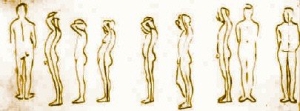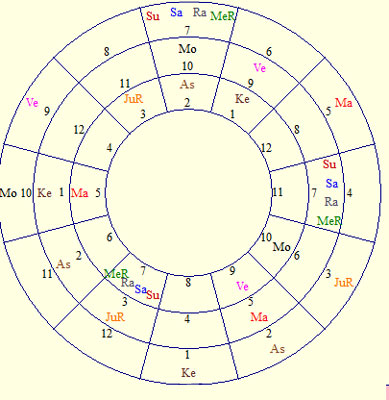The Three Bodies

Every living being comprises three aspects – Sthula, Sukshma and Karana (gross, subtle and causal). Humans have a physical body, made up of the five elements. Surrounding the physical body is the subtle body – sometimes called the astral body. Deep within the physical and subtle bodies exists the causal body, the consciousness within, the source of the “I” that everyone utters; it is in association with the Knower and the Knowing Principle. These three bodies may be examined from the birth chart.
The Gross Body
The gross body – that is, our physical body, is called Sthula sarira. This body contains the five elements of earth, water, air, fire and space. From the element of Earth we have bone, skin, flesh, veins, hair. From the element of water, we have blood, urine, saliva, phlegm, brain. From the element of fire, we have hunger (fire is contained in the stomach and is the energy used to digest food), thirst, sleep, sloth, comradeship. The air element within produces activity, movement, speed, shame, fear. The space element (Akasa in Sanskrit) is responsible for lust, anger, greed, pride and envy.
The gross body belongs to the wakeful state. It comprises the physical body which undergoes change and dies. It is also known as the gross-body-sheath or Annamaya kosa (food sheath). It has many active principles within: the five inner senses, the five vital airs, the five instruments of inner knowing, the five instruments of inner perception and the five instruments of action (vocal organs, hands, legs, genital organs, excretory organs). Thus it is said that the gross body has five encasements.
The Subtle Body
Sukshma Sarira (that is, the thoughts and feelings) is the body layer which can not be seen or touched, such as the human mind. Sukshma Sarira (subtle body) is the source from which our words and deeds originate. The sukshma sarira – sometimes called the astral body – belongs to the state of sleep or the dream state. It is made up of Pranomaya, Manomaya and Vijanamaya koshas (sheaths around the human body).
The Sukshma body comprises of 5 Jnanendriyas (internal senses of perception), the 5 Than-Maathras (subtle senses of knowing, the sense of hearing throught the ears, the sense of touch through the skin, the sense of sight through the eyes, the sense of taste through the tongue and the sense of smell through the nose), , the 5 Prasnas (Samana, Vyana, Udana, Prana and Apana), the Mind and the Intellect. These 17 categories combine to constitute the subtle body.
The Causal Body
The Causal body is called karana deha in Sanskrit. It belongs to the sushupti or deep sleep state. It is the body of ignorance. It is not aware of itself and because of this lack of knowledge (a-vidya) it is subject to rebirth. It comprises the vasanas (impulses to action which accompany the soul from birth to birth). It is also known as the causal body sheath or anandamaya kosha. The causal body is made up of chittam (consciousness), the Knower, the knowing principle and the cogniser, in sanskrit – jnaatha.
Vasanas are cravings, desires, tendencies, instincts and character traits which have been carried over from birth to birth. They encircle the firmament of the soul and one of the four tasks of the knower of Divinity is to give up the vasanas. When we take away the fuel, the fire dies out. Take away the vasanas, the force of impulses, promptings and urges, you become your own master. (It is critical to understand that most people are sleepwalking through their lives; they are being led about by their minds. They have no idea that the mind is actually a servant, an instrument to do what it is instructed to do. Hence the saying “Master the mind and be a mastermind“.)
There are four main vasanas, that of the body (desiring a beautiful physique, attractive musculature and glossy skin), the vasana of the mind (craving to be know as the unrivalled expert in one’s field of knowledge), the vasana of wealth (craving for glory, power, personal pomp and wealth) and the vasana of sex, (titillation, excitation of the senses and passions, continual craving for more sexual activity, eroticism). It is these vasanas which accompany the soul in the form of impulses, promptings, various forms of desire, etc. When indulged – or missed out on – they become the Ari Shadvargas, the six internal enemies of man: lust, anger, greed, attachment, arrogance and conceit, and jealousy.
Vedic Astrology and the Three Bodies
Vedic Astrology has physical, psychological, medical and spiritual dimensions. It addresses all aspects of the human person – principally from an astral perspective. Vedic astrology primarily depicts the astral body of the incoming soul that takes birth at a specific time and place. The Sol of the Solar Sun directs light to the planets who in turn reflect, recombine, and send cosmic and magnetic energies into the three bodies that form the human being. Thus do we use the talents of Astrology to discern the makeup, composition, character and future of the encasement of three bodies which we call The Human Person.
The physical body in astrology is determined from the first house; the Ascendant, planets therein, its ruler and the nature of the influences upon them. As all life is action, it is also connected to the planet Mars, the planet of work in the material world.
Other parts of the body are also signified in the birth chart, as this depicts the body of the Kalapurusha; hence, the first house is the head, the second house is the face, the third house is the breast, the fourth house is the circulatory region, the fifth house the upper stoma and organs, the sixth house is disease in general, the seventh house is the inner organs of reproduction, the eight house represents the external genitalia, the ninth house – the hips and waist, the tenth house the thighs, the eleventh house the knees and calves, the twelfth house, the feet.
The subtle body – or astral body – which has our thoughts and feelings and is the place where all our words and deeds originate from is reflected principally by the Moon – its position and influences in the chart, its sign and nakshatra. It is also reflected by the fourth house, the house of the Mind and its planetary ruler.
The Moon is the presiding deity of the Mind and is most easily afflicted and subsecptible to influences. The Moon is at full strength 180° from the Sun and is at its weakest when it is conjunct the Sun (or combust). The Nakshatras are considered to be the wives of the Moon. In Vedic mythology, the wife of a deity represents the deity’s shakti or power. As wives of the Moon, the nakshatra’s represent the Moon’s power. The Moon represents consciousness and what grows in consciousness; the growth of any planet is dependent on the nakshatra in which it falls.
The causal body is indicated mainly through the Sun, which indicates the personality of the incarnating soul. It indicates will, character and individuality. The Sun’s placement in the chart, as well as the fifth and ninth houses (the houses of dharma – right conduct), and the Navamsha chart (D9).
A well-placed Sun gives intelligence, perception, and strength of will and character. It affords endurance, stamina, vitality, positive spirit, direction, courage, conviction, confidence, leadership, independence and straightforwardness. Without it, whatever we may do or accomplish in life will not be ours and will not give us inner strength or peace. A poorly placed Sun gives lack of intelligence, poor perception, weakness of will and character. It creates lack of endurance, low vitality, melancholy, fear, dependency or servitude, deviousness or dishonesty.
The Ascendant, Moon and Sun are closely examined to delineate the three bodies that comprise the human person, so that we may understand our physical makeup, our subtle body and the causal body, and the influences on the life unfolding. This is often illustrated in the Sudharshan Chakra, a circular chart which places the ascendant, the Moon and Sun charts together.

Parashara indicates that the Sudarshan Chakra was originally revealed to him by Lord Brahma himself for the welfare of mankind (loka sevanam). The Sudarshan Chakra is not normally used by astrologers to make daily predictions, however it has immense value in examining the prevailing influences from the causal body to the subtle body and thence the physical body. There can be peace, there can be friction between the basic nature of the person and the impulses emerging from within. The gunas (impulses to action which are either peaceful, excitable or slothful) can be aligned to houses and planetary influences. Thus, understanding the various influences, whilst appearing complicated at first, can lead to a significant understanding of the character and temperament of the incarnated personality.
(To be continued)
![]()
